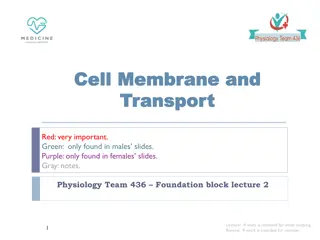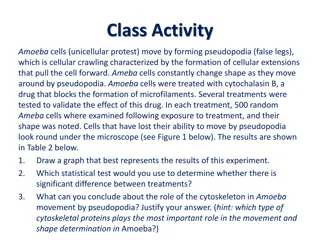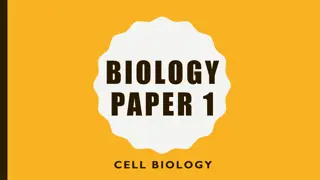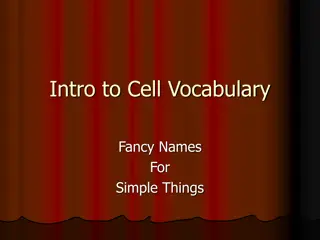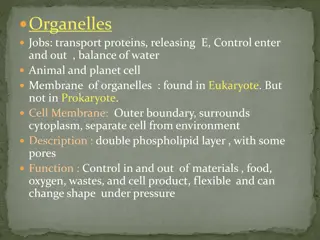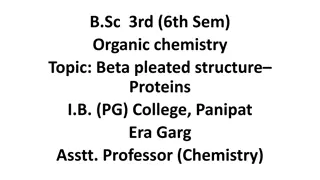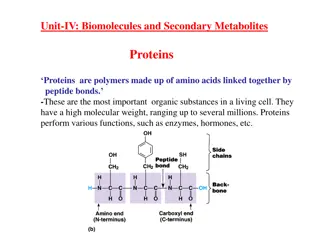Understanding Motor Proteins and Cytoskeletal Dynamics in Cell Biology
Motor proteins, such as myosin, kinesin, and dynein, utilize chemical energy to move along cellular tracks, influencing processes like muscle contraction, organelle movements, and cellular migration. With the ability to translocate using ATP hydrolysis, these proteins play crucial roles in various cellular activities. Actin filaments and microtubules serve as tracks for motor proteins, facilitating cellular processes like actin treadmilling and muscle contraction through intricate mechanisms involving cytoskeletal dynamics.
Download Presentation

Please find below an Image/Link to download the presentation.
The content on the website is provided AS IS for your information and personal use only. It may not be sold, licensed, or shared on other websites without obtaining consent from the author. Download presentation by click this link. If you encounter any issues during the download, it is possible that the publisher has removed the file from their server.
E N D
Presentation Transcript
Motor Proteins (Translocases) use chemical energy to move themselves along a linear track, with the direction of sliding dependent on the structural polarity of the track. do work (force x distance) by coupling nucleoside triphosphate (ATP, GTP, UTP ) hydrolysis to a large-scale conformational change. Examples: muscle contraction, cytokinesis & chromosomal movements, organelle movements, cellular migration, polymerization of DNA, RNA, polysaccharide and protein
Motor Proteins (continued) That walk on cytoskeletal tracks Three superfamilies of motor proteins Myosin (walk on actin filaments) Kinesin (walk toward the plus end of microtubules toward cell surface, common ancestor with Myosin) Dynein (walk toward the minus end of microtubules, toward cell interior) Microtububules Actin filaments Tubulin filaments - ends at centromere + ends near cell surface G-actin (monomer) F-actin (assembled in microfilament) dynamic and rapid remodeling
Motor Proteins (in general) Bind ATP Hydrolyze ATP Release Phosphate & Translocate (move) Release ADP Repeat
Rapid growth at the barbed end of the new branch pushes the membrane forward. Capping protein terminates growth within a second or two. Filaments age by hydrolysis of ATP bound to each actin subunit (white subunits turn yellow) followed by dissociation of phosphate (subunits turn red). Volume 112, ISSUE 4, P453-465, February 21, 2003 Annual Review of Biophysics and Biomolecular Structure,
Muscle cells contain the sarcoplasmic reticulum (SR), which is a special form of endoplasmic reticulum that is dedicated to Ca2+ handling. SR vacuums Ca2+ ions from the cytosol and stores it. A nerve impulse causes release of Ca2+ ions from the sarcoplasmic reticulum. The released Ca2+ bind to troponin. Ca2+ binding causes a conformational change in the tropomyosin-troponin complexes. This conformational change exposes the myosin-binding sites on the thin filaments. The muscle contracts.
Kinesins. (Example KIF14) couples ATP hydrolysis and microtubule binding to generation of mechanical work. There are three major conformations of the motor domain, Transitions between the three states are governed by microtubule binding, ATP binding, ATP hydrolysis, ADP release and Pi release. 3) the neck-linker controls ATP hydrolysis; an undocked neck-linker prevents the ATP- binding pocket from closing and inhibits ATP hydrolysis; 4) thirteen neck-linker residues are required to assume a stable docked conformation; 5) 6) the two motor domains adopt distinct conformations when bound to the microtubule; and 7) the two-heads-bound-state introduces structural changes in both motor domains of KIF14 dimers.
kinesin kinesin Domain organization of the conventional kinesin heavy-chain dimer, showing the crystal structure of the catalytic domains and the neck. The structure of the stalk and tail are inferred from electron microscopic images and coiled-coil prediction analyses. Regions predicted to form coiled-coils (neck, coil 1, coil 2, coiled-coil tail) and flexible regions (hinge, kink, stalk-tail linker) are indicated. Image from G nther Woehlke









